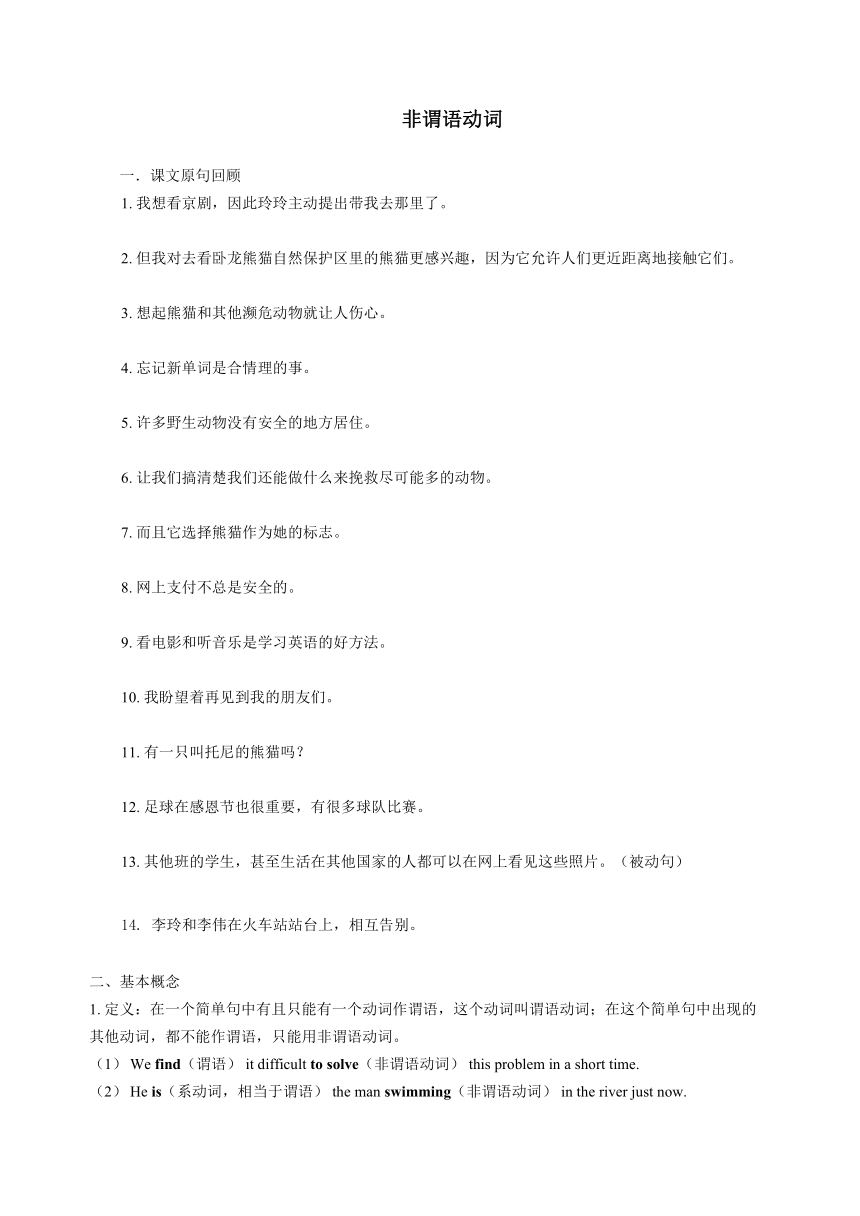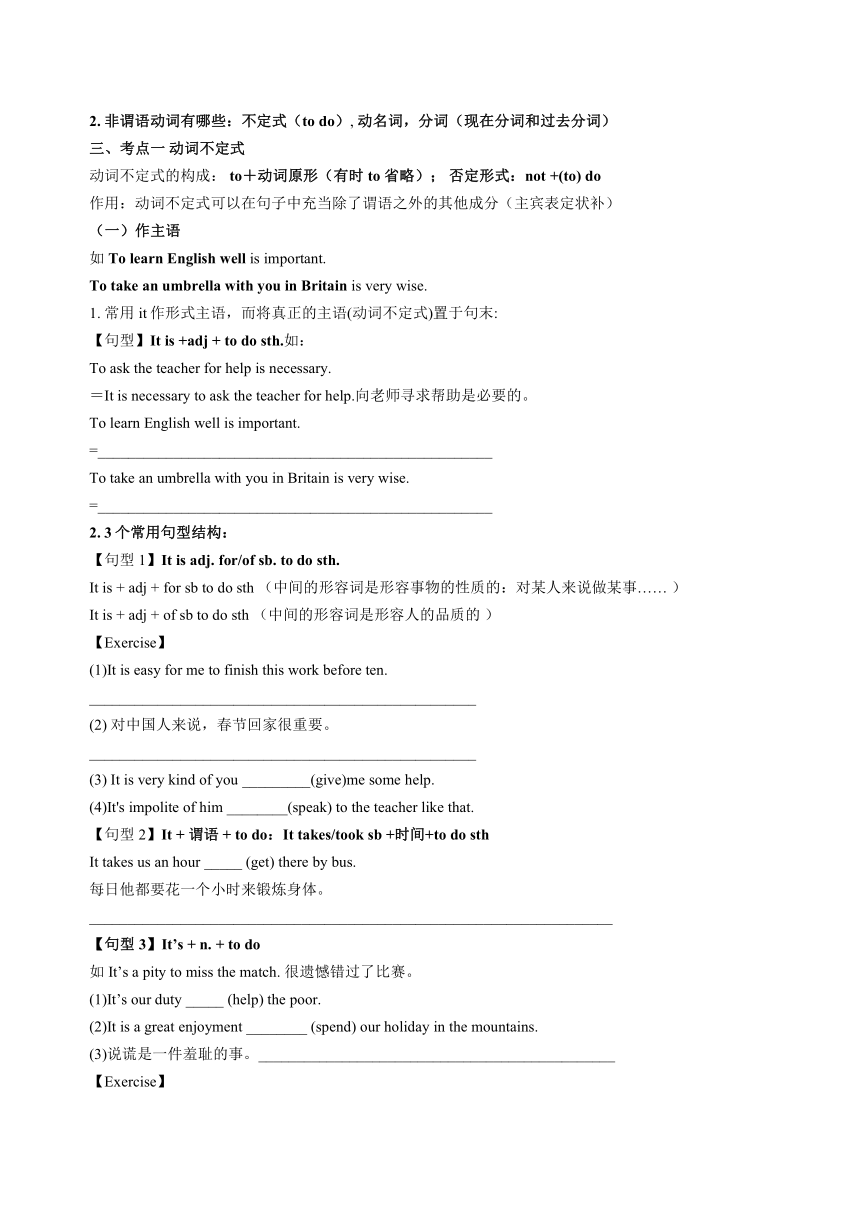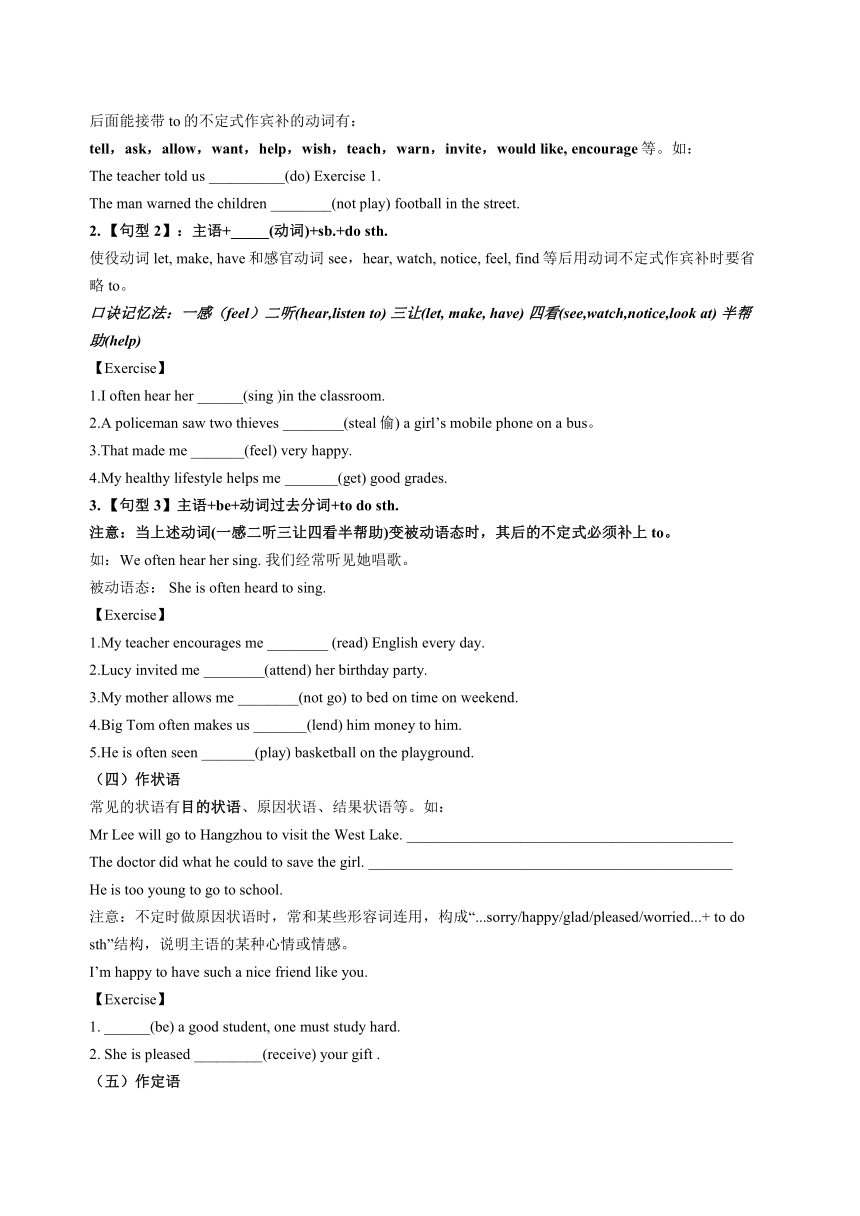2024年外研版中考英语一轮总复习非谓语动词学案(无答案)
文档属性
| 名称 | 2024年外研版中考英语一轮总复习非谓语动词学案(无答案) |

|
|
| 格式 | docx | ||
| 文件大小 | 34.0KB | ||
| 资源类型 | 教案 | ||
| 版本资源 | 外研版 | ||
| 科目 | 英语 | ||
| 更新时间 | 2024-04-30 16:54:55 | ||
图片预览




文档简介
非谓语动词
课文原句回顾
我想看京剧,因此玲玲主动提出带我去那里了。
但我对去看卧龙熊猫自然保护区里的熊猫更感兴趣,因为它允许人们更近距离地接触它们。
想起熊猫和其他濒危动物就让人伤心。
忘记新单词是合情理的事。
许多野生动物没有安全的地方居住。
让我们搞清楚我们还能做什么来挽救尽可能多的动物。
而且它选择熊猫作为她的标志。
网上支付不总是安全的。
看电影和听音乐是学习英语的好方法。
我盼望着再见到我的朋友们。
有一只叫托尼的熊猫吗?
足球在感恩节也很重要,有很多球队比赛。
其他班的学生,甚至生活在其他国家的人都可以在网上看见这些照片。(被动句)
李玲和李伟在火车站站台上,相互告别。
二、基本概念
1. 定义:在一个简单句中有且只能有一个动词作谓语,这个动词叫谓语动词;在这个简单句中出现的其他动词,都不能作谓语,只能用非谓语动词。
(1) We find(谓语) it difficult to solve(非谓语动词) this problem in a short time.
(2) He is(系动词,相当于谓语) the man swimming(非谓语动词) in the river just now.
2. 非谓语动词有哪些:不定式(to do), 动名词,分词(现在分词和过去分词)
三、考点一 动词不定式
动词不定式的构成: to+动词原形(有时to 省略); 否定形式:not +(to) do
作用:动词不定式可以在句子中充当除了谓语之外的其他成分(主宾表定状补)
(一)作主语
如To learn English well is important.
To take an umbrella with you in Britain is very wise.
常用it作形式主语,而将真正的主语(动词不定式)置于句末:
【句型】It is +adj + to do sth.如:
To ask the teacher for help is necessary.
=It is necessary to ask the teacher for help.向老师寻求帮助是必要的。
To learn English well is important.
=____________________________________________________
To take an umbrella with you in Britain is very wise.
=____________________________________________________
3个常用句型结构:
【句型1】It is adj. for/of sb. to do sth.
It is + adj + for sb to do sth (中间的形容词是形容事物的性质的:对某人来说做某事…… )
It is + adj + of sb to do sth (中间的形容词是形容人的品质的 )
【Exercise】
(1)It is easy for me to finish this work before ten.
___________________________________________________
(2) 对中国人来说,春节回家很重要。
___________________________________________________
(3) It is very kind of you _________(give)me some help.
(4)It's impolite of him ________(speak) to the teacher like that.
【句型2】It + 谓语 + to do:It takes/took sb +时间+to do sth
It takes us an hour _____ (get) there by bus.
每日他都要花一个小时来锻炼身体。
_____________________________________________________________________
【句型3】It’s + n. + to do
如It’s a pity to miss the match. 很遗憾错过了比赛。
(1)It’s our duty _____ (help) the poor.
(2)It is a great enjoyment ________ (spend) our holiday in the mountains.
(3)说谎是一件羞耻的事。_______________________________________________
【Exercise】
(1)Is it necessary ____________(learn) a foreign language
(2)It is a great honor _______(talk) with you face to face.
(3)对他来说,保持房间整洁很困难。
__________________________________________________________________
(4)到那里花了我们一整天的时间。
_____________________________________________________________________
(5)他很聪明能够解决这个难题。
_____________________________________________________________________
(二)作宾语
1. 【句型1】:主语+_____(动词)+to do sth.
后接不定式作宾语的动词有 :
打算(intend)计划(plan)和期盼(expect)
假装(pretend)喜欢(would like/love/prefer)和希望(wish/hope)
决定(decide)同意(agree)来帮助(help)
设法(manage)说服(persuade)不拒绝(refuse)
好像(seem/appear)答应(promise)做努力(attempt)
选择(choose)要求(demand)多学习(learn)
安排(arrange)失败(fail)付得起(afford)
【Exercise】
1.They wanted ______( get ) on the bus, didn’t they
2.He said he wished ______( be ) a professor.
3.I agreed______ ( go ) there with the doctor.
4.He had promised ______ ( give ) me a hand.
5.I hope __________ ( get ) there before dark.
6. My daughter preferred ______ ( dance ) when she was in her twenties.
2. 【句型2】:主语+ think/ find/make + it(形式宾语)+宾补(形容词/名词)+to do
在think, find, make等动词后通常用it作形式宾语,而将不定式移至形容词之后,构成“主语+动词+it(形式宾语)+宾补(形容词/名词)+不定式”结构。如:I found it (形式宾语)difficult to solve the problem(真正的宾语)。
【Exercise】
1. He found it not easy _________(do)it well.
2.His invention made it easy__________(get) the information.
3. 我们发现每天大声拼读单词是个好主意。
_____________________________________________________________________
(三)作宾语补足语
1. 【句型1】:主语+_____(动词)+sb.+(not) to do sth.
后面能接带to的不定式作宾补的动词有:
tell,ask,allow,want,help,wish,teach,warn,invite,would like, encourage等。如:
The teacher told us __________(do) Exercise 1.
The man warned the children ________(not play) football in the street.
【句型2】:主语+_____(动词)+sb.+do sth.
使役动词let, make, have和感官动词see,hear, watch, notice, feel, find等后用动词不定式作宾补时要省略to。
口诀记忆法:一感(feel)二听(hear,listen to) 三让(let, make, have) 四看(see,watch,notice,look at) 半帮助(help)
【Exercise】
1.I often hear her ______(sing )in the classroom.
2.A policeman saw two thieves ________(steal偷) a girl’s mobile phone on a bus。
3.That made me _______(feel) very happy.
4.My healthy lifestyle helps me _______(get) good grades.
3. 【句型3】主语+be+动词过去分词+to do sth.
注意:当上述动词(一感二听三让四看半帮助)变被动语态时,其后的不定式必须补上to。
如:We often hear her sing. 我们经常听见她唱歌。
被动语态: She is often heard to sing.
【Exercise】
1.My teacher encourages me ________ (read) English every day.
2.Lucy invited me ________(attend) her birthday party.
3.My mother allows me ________(not go) to bed on time on weekend.
4.Big Tom often makes us _______(lend) him money to him.
5.He is often seen _______(play) basketball on the playground.
(四)作状语
常见的状语有目的状语、原因状语、结果状语等。如:
Mr Lee will go to Hangzhou to visit the West Lake. ___________________________________________
The doctor did what he could to save the girl. ________________________________________________
He is too young to go to school.
注意:不定时做原因状语时,常和某些形容词连用,构成“...sorry/happy/glad/pleased/worried...+ to do sth”结构,说明主语的某种心情或情感。
I’m happy to have such a nice friend like you.
【Exercise】
______(be) a good student, one must study hard.
She is pleased _________(receive) your gift .
(五)作定语
动词不定式作定语时,放在被修饰的名词的后面,作后置定语。
如:I don't have a partner to practice English with.
我没有一个一起练习英语的同伴。
Get him something to eat. 给他弄点吃的东西。
I need a pen to write with. 我需要一支写字的笔。
【Exercise】
1.Joining a summer camp is a great chance_________(spend) free time with your friends.
2.She became the first American woman ____________(receive) the Nobel
3. I have too much work _______(do).
(六)作表语
动词不定式作表语,表示主语的职业、职责或愿望、责任、义务等,一般可以转化为动词不定式做主语。
Their duty is __________________ the animals. 他们的职责是照看动物。
His wish is _____________ a doctor.他的愿望是当一名医生。
(七)“特殊疑问词+不定式”结构:特殊疑问词+to do
动词不定式可以和疑问词what, which, when, where, how等连用,构成不定式短语,在句中作主语、宾语、表语、宾语补足语等。如:
He doesn't know what ________(wear). 他不知道要穿什么。
He taught us how _______(use) the tool. 他教我们怎样使用这个工具。
No one could tell me where _______(get) the book. 没有人能告诉我哪里能拿到这本书。
【不定式综合练习】
1.The policeman told the boys not _______(play) in the street.
2. Her son is too young __________(dress) himself.
3.Why not let him ____(go) home.
4._________(be) honest, I just don’t like him.
5.They were made _____(work) fourteen hours a day.
6.“Do you have any clothes _______ (wash) ” asked the maid.
7.Don’t let those who are not old enough _______ (enter) the video game arcade.
8. I really don’t know what______(do) next.
9.Can you finish ___________(read) the book in three days
10. I often hear people _________(say) “__________(see) is ____________(believe)”.
11.His wish was ____________(become) a doctor.
12.They said they had nothing _________(worry) about.
三、考点二 动名词
动名词由“动词原形+ing”构成,其与现在分词同形。动名词既有动词的性质,也有名词的性质。在句中可作主语、宾语、表语和定语。
(一)作主语
1.动名词直接作主语(单个动作作主语谓语动词用单数,两个和多个动名词作主语其后谓语用复数)
Playing computer games too much /is bad for your eyes.过度地玩电脑游戏对你的眼睛有害。
Listening to English songs and watching English films/ are good ways to learn English.
听英文歌和看英文电影是学习英语的好方法。
2.动名词作主语时,有时可以用it做形式主语。
It is useless/ no good/ no use doing sth. 做某事是无用的。
It’s no use saying so much. 说这么多也没有用。
It’s no good _______(live) in this way. 用这种方式生活没有好处。
注意:动名词作主语和动词不定式作主语,在很多情况下可以通用。但,动名词作主语多之一般的,抽象的或多次的行为,动词不定式作主语往往表示一次性具体的动作。
【Exercise】
1.________(eat) too much snacks and drinking a lot of cola _____(be) bad for your health.
2.It’s useless _______(cry) without doing anything.
3.I don’t think ________(smoke) is allowed here.
4.________(sleep) for such a long time makes me_______(have)a headache.
(二)作宾语
常接动名词作宾语的单词或短语有:
动词: enjoy, finish, consider (考虑做), miss, keep, mind(介意做)practise/practice, suggest,
avoid(避免做), imagine想象
短语:
be busy(忙于做) can’t help(情不自禁做) can’t stop(停不下做) have fun (做某事获得快乐)
介词后加Ving:
be/get used to(习惯于做) be worth(做某事值得) be afraid of(害怕做) be proud of(做某事感到骄傲) be interested in(对做某事感兴趣) look forward to(期盼做) put off(推迟做) keep sb from doing ; stop/prevent sb (from)doing(阻止某人做某事)
feel like(想要做) give up(放弃做) have trouble/difficulty (in) doing (做某事有困难)
prefer doing sth to doing sth(喜欢做某事胜过做某事) sb. spend(s) time (in) doing sth等。
【Exercise】
1.He is busy _________(mend) his chair.
2.Have you finished __________ (read) the book
3.Would you mind_____________(speak) slowly?I can’t follow you.
4.I’m sorry to keep you ____________(wait) for a long time.
5.I feel like ___________(see) some humorous movies.
注意:有些词既可接不定式又可接v. ing形式作宾语,但表达的意义不同。常见的有:
(1)stop to do sth停下来去做另外一件事(不定式作目的状语)
stop doing sth停止做某事(v. ing作宾语)
(2)try to do sth 试图(企图)做某事 try doing sth尝试着做某事
(3)forget to do sth忘记要去做某事(还没做)
forget doing sth忘记做过了某事(已做)
(4)remember to do sth记着要去做某事(还没做)
remember doing sth记得做过了某事(已做)
(5)go on to do sth做完一件事后继续做另外一件不同的事
go on doing sth继续做原来所做的同一件事
(6)need doing(某事)需要做(被动含义) need to do 需要去做某事(主动含义)
(三)作定语
动名词作定语,一般只限于单个的动名词作定语,表明它所修饰的词的用途、所属关系等,一般置于被修饰词前面。
waiting room reading room living room English-speaking country
【动名词综合练习】
1.Do you feel like _______ (have) a walk along the river
2.He has trouble_______(solve) the problem. Let’s help him.
3.Thank you very much for ____________(help) us.
4.The doctor was busy ___________(operate) on the boy at that time.
5.We couldn’t help ________(laugh) after we heard the funny story.
6.My grandfather is used to _______(wear) a hat in winter.
7.Would you mind __________(not smoke) because there’re so many children ________(play) here
8.________(read) English is much easier than speaking it.
9.Her hobby is __________(collect) model planes.
10.You’d better___________(take)an umbrella with you.
11.Although they are tired, they still go on_____________(work).
12.—Don’t forget____________(see) my parents when you are in Beijing.
13.Kate spent 30 minutes _______(clean) his bike.
三、考点三 分词
1. 分词分为 现在分词(v-ing) 和 过去分词(v-ed) 两种。分词在句中可作定语、状语、表语和补语。
2. 现在分词和过去分词的用法区别
(1)现在分词(v-ing) 表主动、进行之意,在句中可作定语、状语、表语和补语。
The crying girl can’t find her mother.(前置定语,表进行) 那个正在哭的女孩找不到妈妈了。
What about the photo of my cousin flying kites with Chinese kids in the Summer Palace. (后置定语,表进行)
I saw her going upstairs.我看见她正在上楼。(宾补,表进行)
Hearing the bad news, they couldn’t help crying.(状语,表主动)
过去分词(v-ed) 表被动、完成之意,句中可作定语、状语、 表语和补语。
I know the boy called Li Ming.(作定语,表被动) 我认识那个叫李明的男孩。
She found the novel written by Mark Twain. (宾补,表被动) 她发现这本小说是马克吐温写的。
My chocolate cookies are done now.(作表语,表完成) 我的巧克力饼干做好了。
Broken by Jim, I can’t use the cup. (作状语,表被动) 杯子被Jim打破了,我不能用了。
(3)其它区别:现在分词表示事物本身所具有的性质,意为“令人……”,过去分词表示由外界引起的内心活动,意为“感到……”
the exciting news 令人激动的消息 the excited look 激动的表情
surprising令人惊讶的 surprised感到惊讶的
(4)易混结构
have sb doing sth 与have sth done 的区别:
(1)have sb doing sth 意为“让某人一直做某事”, doing这个动作具有持续意义。如:
The teacher had the boys standing all day. 老师让男生罚站了一整天。
(2)have sth done 意为“让某事被做”,表示让他人完成,有被动之意。
如:I had my computer repaired yesterday. 昨天我让人修理了我的电脑。
【分词综合练习】
1.China is a __________(develop) country. America is a _________(develop) country.
中国是一个发展中国家,美国是一个发达国家
2. I often hear her ________(sing) this song in the classroom after class.
Listen!I hear someone_________(sing) in the classroom.
3. Please stop ________(have) a rest if you feel tired.
4.It’s a pity that I forgot to take my _________(swim) clothes.
5. Jack took an interest in _______(play) ping-pong soon after he came to China.
6. Seeing their teacher _________(enter) into the classroom, they stopped ________(talk) at once.
7.When I was walking past the window, I noticed Wang Fei________(copy) my homework. I really got_______(amaze).
8. Some photos ________(take)by the children of Yushu, Qinghai are on show now.
9. ________(hear) the good news, he jumped with joy.
10. When I went into the room,I found him________(lie) in bed.
四、非谓语达标检测(另附习题学案)
课文原句回顾
我想看京剧,因此玲玲主动提出带我去那里了。
但我对去看卧龙熊猫自然保护区里的熊猫更感兴趣,因为它允许人们更近距离地接触它们。
想起熊猫和其他濒危动物就让人伤心。
忘记新单词是合情理的事。
许多野生动物没有安全的地方居住。
让我们搞清楚我们还能做什么来挽救尽可能多的动物。
而且它选择熊猫作为她的标志。
网上支付不总是安全的。
看电影和听音乐是学习英语的好方法。
我盼望着再见到我的朋友们。
有一只叫托尼的熊猫吗?
足球在感恩节也很重要,有很多球队比赛。
其他班的学生,甚至生活在其他国家的人都可以在网上看见这些照片。(被动句)
李玲和李伟在火车站站台上,相互告别。
二、基本概念
1. 定义:在一个简单句中有且只能有一个动词作谓语,这个动词叫谓语动词;在这个简单句中出现的其他动词,都不能作谓语,只能用非谓语动词。
(1) We find(谓语) it difficult to solve(非谓语动词) this problem in a short time.
(2) He is(系动词,相当于谓语) the man swimming(非谓语动词) in the river just now.
2. 非谓语动词有哪些:不定式(to do), 动名词,分词(现在分词和过去分词)
三、考点一 动词不定式
动词不定式的构成: to+动词原形(有时to 省略); 否定形式:not +(to) do
作用:动词不定式可以在句子中充当除了谓语之外的其他成分(主宾表定状补)
(一)作主语
如To learn English well is important.
To take an umbrella with you in Britain is very wise.
常用it作形式主语,而将真正的主语(动词不定式)置于句末:
【句型】It is +adj + to do sth.如:
To ask the teacher for help is necessary.
=It is necessary to ask the teacher for help.向老师寻求帮助是必要的。
To learn English well is important.
=____________________________________________________
To take an umbrella with you in Britain is very wise.
=____________________________________________________
3个常用句型结构:
【句型1】It is adj. for/of sb. to do sth.
It is + adj + for sb to do sth (中间的形容词是形容事物的性质的:对某人来说做某事…… )
It is + adj + of sb to do sth (中间的形容词是形容人的品质的 )
【Exercise】
(1)It is easy for me to finish this work before ten.
___________________________________________________
(2) 对中国人来说,春节回家很重要。
___________________________________________________
(3) It is very kind of you _________(give)me some help.
(4)It's impolite of him ________(speak) to the teacher like that.
【句型2】It + 谓语 + to do:It takes/took sb +时间+to do sth
It takes us an hour _____ (get) there by bus.
每日他都要花一个小时来锻炼身体。
_____________________________________________________________________
【句型3】It’s + n. + to do
如It’s a pity to miss the match. 很遗憾错过了比赛。
(1)It’s our duty _____ (help) the poor.
(2)It is a great enjoyment ________ (spend) our holiday in the mountains.
(3)说谎是一件羞耻的事。_______________________________________________
【Exercise】
(1)Is it necessary ____________(learn) a foreign language
(2)It is a great honor _______(talk) with you face to face.
(3)对他来说,保持房间整洁很困难。
__________________________________________________________________
(4)到那里花了我们一整天的时间。
_____________________________________________________________________
(5)他很聪明能够解决这个难题。
_____________________________________________________________________
(二)作宾语
1. 【句型1】:主语+_____(动词)+to do sth.
后接不定式作宾语的动词有 :
打算(intend)计划(plan)和期盼(expect)
假装(pretend)喜欢(would like/love/prefer)和希望(wish/hope)
决定(decide)同意(agree)来帮助(help)
设法(manage)说服(persuade)不拒绝(refuse)
好像(seem/appear)答应(promise)做努力(attempt)
选择(choose)要求(demand)多学习(learn)
安排(arrange)失败(fail)付得起(afford)
【Exercise】
1.They wanted ______( get ) on the bus, didn’t they
2.He said he wished ______( be ) a professor.
3.I agreed______ ( go ) there with the doctor.
4.He had promised ______ ( give ) me a hand.
5.I hope __________ ( get ) there before dark.
6. My daughter preferred ______ ( dance ) when she was in her twenties.
2. 【句型2】:主语+ think/ find/make + it(形式宾语)+宾补(形容词/名词)+to do
在think, find, make等动词后通常用it作形式宾语,而将不定式移至形容词之后,构成“主语+动词+it(形式宾语)+宾补(形容词/名词)+不定式”结构。如:I found it (形式宾语)difficult to solve the problem(真正的宾语)。
【Exercise】
1. He found it not easy _________(do)it well.
2.His invention made it easy__________(get) the information.
3. 我们发现每天大声拼读单词是个好主意。
_____________________________________________________________________
(三)作宾语补足语
1. 【句型1】:主语+_____(动词)+sb.+(not) to do sth.
后面能接带to的不定式作宾补的动词有:
tell,ask,allow,want,help,wish,teach,warn,invite,would like, encourage等。如:
The teacher told us __________(do) Exercise 1.
The man warned the children ________(not play) football in the street.
【句型2】:主语+_____(动词)+sb.+do sth.
使役动词let, make, have和感官动词see,hear, watch, notice, feel, find等后用动词不定式作宾补时要省略to。
口诀记忆法:一感(feel)二听(hear,listen to) 三让(let, make, have) 四看(see,watch,notice,look at) 半帮助(help)
【Exercise】
1.I often hear her ______(sing )in the classroom.
2.A policeman saw two thieves ________(steal偷) a girl’s mobile phone on a bus。
3.That made me _______(feel) very happy.
4.My healthy lifestyle helps me _______(get) good grades.
3. 【句型3】主语+be+动词过去分词+to do sth.
注意:当上述动词(一感二听三让四看半帮助)变被动语态时,其后的不定式必须补上to。
如:We often hear her sing. 我们经常听见她唱歌。
被动语态: She is often heard to sing.
【Exercise】
1.My teacher encourages me ________ (read) English every day.
2.Lucy invited me ________(attend) her birthday party.
3.My mother allows me ________(not go) to bed on time on weekend.
4.Big Tom often makes us _______(lend) him money to him.
5.He is often seen _______(play) basketball on the playground.
(四)作状语
常见的状语有目的状语、原因状语、结果状语等。如:
Mr Lee will go to Hangzhou to visit the West Lake. ___________________________________________
The doctor did what he could to save the girl. ________________________________________________
He is too young to go to school.
注意:不定时做原因状语时,常和某些形容词连用,构成“...sorry/happy/glad/pleased/worried...+ to do sth”结构,说明主语的某种心情或情感。
I’m happy to have such a nice friend like you.
【Exercise】
______(be) a good student, one must study hard.
She is pleased _________(receive) your gift .
(五)作定语
动词不定式作定语时,放在被修饰的名词的后面,作后置定语。
如:I don't have a partner to practice English with.
我没有一个一起练习英语的同伴。
Get him something to eat. 给他弄点吃的东西。
I need a pen to write with. 我需要一支写字的笔。
【Exercise】
1.Joining a summer camp is a great chance_________(spend) free time with your friends.
2.She became the first American woman ____________(receive) the Nobel
3. I have too much work _______(do).
(六)作表语
动词不定式作表语,表示主语的职业、职责或愿望、责任、义务等,一般可以转化为动词不定式做主语。
Their duty is __________________ the animals. 他们的职责是照看动物。
His wish is _____________ a doctor.他的愿望是当一名医生。
(七)“特殊疑问词+不定式”结构:特殊疑问词+to do
动词不定式可以和疑问词what, which, when, where, how等连用,构成不定式短语,在句中作主语、宾语、表语、宾语补足语等。如:
He doesn't know what ________(wear). 他不知道要穿什么。
He taught us how _______(use) the tool. 他教我们怎样使用这个工具。
No one could tell me where _______(get) the book. 没有人能告诉我哪里能拿到这本书。
【不定式综合练习】
1.The policeman told the boys not _______(play) in the street.
2. Her son is too young __________(dress) himself.
3.Why not let him ____(go) home.
4._________(be) honest, I just don’t like him.
5.They were made _____(work) fourteen hours a day.
6.“Do you have any clothes _______ (wash) ” asked the maid.
7.Don’t let those who are not old enough _______ (enter) the video game arcade.
8. I really don’t know what______(do) next.
9.Can you finish ___________(read) the book in three days
10. I often hear people _________(say) “__________(see) is ____________(believe)”.
11.His wish was ____________(become) a doctor.
12.They said they had nothing _________(worry) about.
三、考点二 动名词
动名词由“动词原形+ing”构成,其与现在分词同形。动名词既有动词的性质,也有名词的性质。在句中可作主语、宾语、表语和定语。
(一)作主语
1.动名词直接作主语(单个动作作主语谓语动词用单数,两个和多个动名词作主语其后谓语用复数)
Playing computer games too much /is bad for your eyes.过度地玩电脑游戏对你的眼睛有害。
Listening to English songs and watching English films/ are good ways to learn English.
听英文歌和看英文电影是学习英语的好方法。
2.动名词作主语时,有时可以用it做形式主语。
It is useless/ no good/ no use doing sth. 做某事是无用的。
It’s no use saying so much. 说这么多也没有用。
It’s no good _______(live) in this way. 用这种方式生活没有好处。
注意:动名词作主语和动词不定式作主语,在很多情况下可以通用。但,动名词作主语多之一般的,抽象的或多次的行为,动词不定式作主语往往表示一次性具体的动作。
【Exercise】
1.________(eat) too much snacks and drinking a lot of cola _____(be) bad for your health.
2.It’s useless _______(cry) without doing anything.
3.I don’t think ________(smoke) is allowed here.
4.________(sleep) for such a long time makes me_______(have)a headache.
(二)作宾语
常接动名词作宾语的单词或短语有:
动词: enjoy, finish, consider (考虑做), miss, keep, mind(介意做)practise/practice, suggest,
avoid(避免做), imagine想象
短语:
be busy(忙于做) can’t help(情不自禁做) can’t stop(停不下做) have fun (做某事获得快乐)
介词后加Ving:
be/get used to(习惯于做) be worth(做某事值得) be afraid of(害怕做) be proud of(做某事感到骄傲) be interested in(对做某事感兴趣) look forward to(期盼做) put off(推迟做) keep sb from doing ; stop/prevent sb (from)doing(阻止某人做某事)
feel like(想要做) give up(放弃做) have trouble/difficulty (in) doing (做某事有困难)
prefer doing sth to doing sth(喜欢做某事胜过做某事) sb. spend(s) time (in) doing sth等。
【Exercise】
1.He is busy _________(mend) his chair.
2.Have you finished __________ (read) the book
3.Would you mind_____________(speak) slowly?I can’t follow you.
4.I’m sorry to keep you ____________(wait) for a long time.
5.I feel like ___________(see) some humorous movies.
注意:有些词既可接不定式又可接v. ing形式作宾语,但表达的意义不同。常见的有:
(1)stop to do sth停下来去做另外一件事(不定式作目的状语)
stop doing sth停止做某事(v. ing作宾语)
(2)try to do sth 试图(企图)做某事 try doing sth尝试着做某事
(3)forget to do sth忘记要去做某事(还没做)
forget doing sth忘记做过了某事(已做)
(4)remember to do sth记着要去做某事(还没做)
remember doing sth记得做过了某事(已做)
(5)go on to do sth做完一件事后继续做另外一件不同的事
go on doing sth继续做原来所做的同一件事
(6)need doing(某事)需要做(被动含义) need to do 需要去做某事(主动含义)
(三)作定语
动名词作定语,一般只限于单个的动名词作定语,表明它所修饰的词的用途、所属关系等,一般置于被修饰词前面。
waiting room reading room living room English-speaking country
【动名词综合练习】
1.Do you feel like _______ (have) a walk along the river
2.He has trouble_______(solve) the problem. Let’s help him.
3.Thank you very much for ____________(help) us.
4.The doctor was busy ___________(operate) on the boy at that time.
5.We couldn’t help ________(laugh) after we heard the funny story.
6.My grandfather is used to _______(wear) a hat in winter.
7.Would you mind __________(not smoke) because there’re so many children ________(play) here
8.________(read) English is much easier than speaking it.
9.Her hobby is __________(collect) model planes.
10.You’d better___________(take)an umbrella with you.
11.Although they are tired, they still go on_____________(work).
12.—Don’t forget____________(see) my parents when you are in Beijing.
13.Kate spent 30 minutes _______(clean) his bike.
三、考点三 分词
1. 分词分为 现在分词(v-ing) 和 过去分词(v-ed) 两种。分词在句中可作定语、状语、表语和补语。
2. 现在分词和过去分词的用法区别
(1)现在分词(v-ing) 表主动、进行之意,在句中可作定语、状语、表语和补语。
The crying girl can’t find her mother.(前置定语,表进行) 那个正在哭的女孩找不到妈妈了。
What about the photo of my cousin flying kites with Chinese kids in the Summer Palace. (后置定语,表进行)
I saw her going upstairs.我看见她正在上楼。(宾补,表进行)
Hearing the bad news, they couldn’t help crying.(状语,表主动)
过去分词(v-ed) 表被动、完成之意,句中可作定语、状语、 表语和补语。
I know the boy called Li Ming.(作定语,表被动) 我认识那个叫李明的男孩。
She found the novel written by Mark Twain. (宾补,表被动) 她发现这本小说是马克吐温写的。
My chocolate cookies are done now.(作表语,表完成) 我的巧克力饼干做好了。
Broken by Jim, I can’t use the cup. (作状语,表被动) 杯子被Jim打破了,我不能用了。
(3)其它区别:现在分词表示事物本身所具有的性质,意为“令人……”,过去分词表示由外界引起的内心活动,意为“感到……”
the exciting news 令人激动的消息 the excited look 激动的表情
surprising令人惊讶的 surprised感到惊讶的
(4)易混结构
have sb doing sth 与have sth done 的区别:
(1)have sb doing sth 意为“让某人一直做某事”, doing这个动作具有持续意义。如:
The teacher had the boys standing all day. 老师让男生罚站了一整天。
(2)have sth done 意为“让某事被做”,表示让他人完成,有被动之意。
如:I had my computer repaired yesterday. 昨天我让人修理了我的电脑。
【分词综合练习】
1.China is a __________(develop) country. America is a _________(develop) country.
中国是一个发展中国家,美国是一个发达国家
2. I often hear her ________(sing) this song in the classroom after class.
Listen!I hear someone_________(sing) in the classroom.
3. Please stop ________(have) a rest if you feel tired.
4.It’s a pity that I forgot to take my _________(swim) clothes.
5. Jack took an interest in _______(play) ping-pong soon after he came to China.
6. Seeing their teacher _________(enter) into the classroom, they stopped ________(talk) at once.
7.When I was walking past the window, I noticed Wang Fei________(copy) my homework. I really got_______(amaze).
8. Some photos ________(take)by the children of Yushu, Qinghai are on show now.
9. ________(hear) the good news, he jumped with joy.
10. When I went into the room,I found him________(lie) in bed.
四、非谓语达标检测(另附习题学案)
